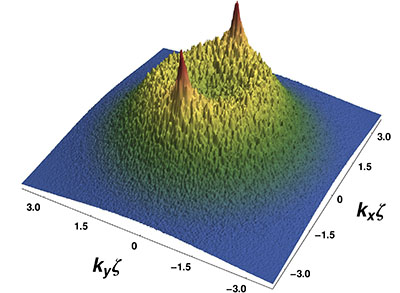Nov 23 2012
Experiments could search for a 'twin peak' to gain insight into the peculiar phenomenon of wave localisation, CQT researchers and their collaborators have predicted.
 New insight into Anderson localistion could stem from the prediction of a 'twin peak' signal associated with the important but not well-understood wave-interference phenomenon. From Phys. Rev. Lett. 109, 190601 (2012).
New insight into Anderson localistion could stem from the prediction of a 'twin peak' signal associated with the important but not well-understood wave-interference phenomenon. From Phys. Rev. Lett. 109, 190601 (2012).
Waves trying to propagate in a strongly disordered environment can end up confined by a mechanism known as Anderson localisation, which is caused by interference. The researchers' new calculations suggest the localisation should be accompanied by a twin-peak signal in the wave's velocity distribution, something never seen before. The work is published in Physical Review Letters.
The idea that disorder could stop waves dead was surprising when it was predicted in 1958, and remained largely obscure until Anderson was awarded a Nobel prize in 1977. Indeed, the effect is counter to how particles behave when they move through a disordered obstacle course: particles tend to diffuse and slowly spread out to infinity. The tendency of waves to localise instead has since been recognised as important to understanding metal-insulator transitions and wave propagation in random media. Now there are even proposals to exploit localisation through disorder in applications as diverse as solar cells and quantum memories.
However, the phenomenon is hard to detect conclusively in real-world experiments and is still, more than 50 years on, not well understood. One reason for Anderson localisation being hard to spot experimentally is that the absence of diffusion can also be caused by entirely different mechanisms. The twin peak signal could provide a distinctive signature, and potentially applies to many different systems.
Atoms cooled to near absolute zero show collective wave-like behaviour — known as Bose-Einstein condensation — and the propagation of these quantum matter waves is also influenced by disorder. For an earlier paper, team-members Tomasz Karpiuk, Benoît Grémaud, Cord Müller and Christian Miniatura from CQT, with collaborator Nicolas Cherroret, performed detailed numerical and analytical calculations for a phenomenon known as "coherent back-scattering" (CBS), which heralds 'weak localisation', the precursor of Anderson localisation in a weakly disordered medium.
It has been known for a long time that interference enhances the probability that a travelling wave will be scattered backwards, giving rise to a single coherent back-scattering (CBS) peak. CBS signals are routinely used to measure the phase coherence of waves as vastly different as electronic, electromagnetic, acoustic and seismic. The teams' ideas about how a CBS peak in the velocity distribution of cold atoms could be measured were published in Physical Review A.
Experiments carried out since at Institut d'Optique in Palaiseau, France, have borne out the predictions, as described in a recent paper highlighted in Physical Review Letters. "The proposed experiment was brilliantly realised by our colleagues from Palaiseau, and the data are just beautiful," says Cord.
The team has strong connections with France. Benoît and Christian are both researchers with the French national research organisation CNRS, who hold joint appointments in Singapore thanks to the creation in 2011 of an "International Associated Laboratory", the LIA FSQL, with CNRS and affiliated organisations. The LIA also supports Tomasz and new team member CQTian Lee Kean Loon, who joined the group to continue the research.
Extending the numerical simulations from the first paper to longer times and stronger disorder, the team discovered an unexpected second signal. On entering the strong localisation regime, a coherent forward scattering (CFS) signal appears and complements the CBS signal. Intuitively, the CFS peak in the wave's velocity distribution appears because net transport has to stop when Anderson localisation sets in. Enhanced back-scattering must therefore be compensated by an equal amount of enhanced forward-scattering. The team proposes a detailed theoretical explanation that is based on the interference already responsible for CBS. This explanation highlights the role of the so-called Heisenberg time scale associated with the localisation volume.
The quick experimental observation of CBS with cold atoms makes the team confident that their new prediction will soon be tested with cold atoms. Also, experimentalists working with laser light that is scattered by strongly disordered media have expressed interest in this prediction and will try to search for the double-peak signal. The twin peak signal promises to provide new insights into how waves move when they localise.